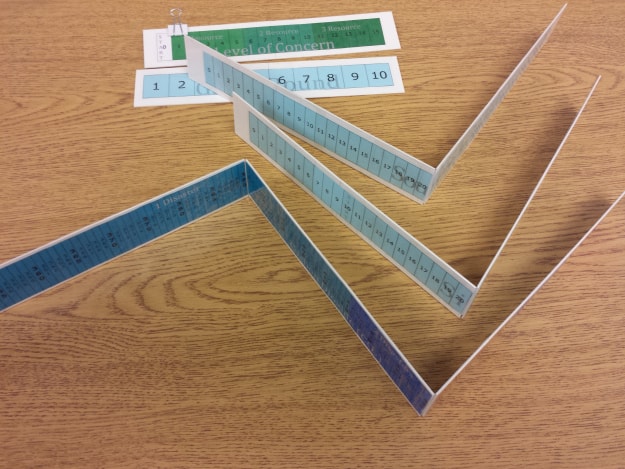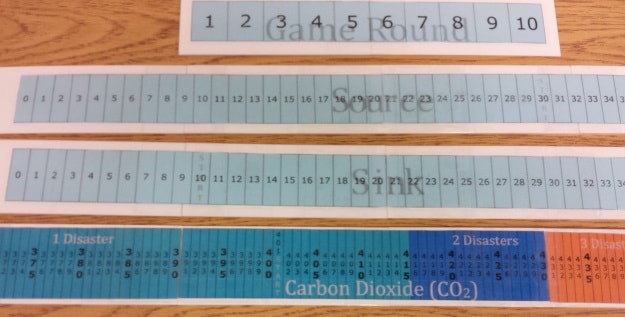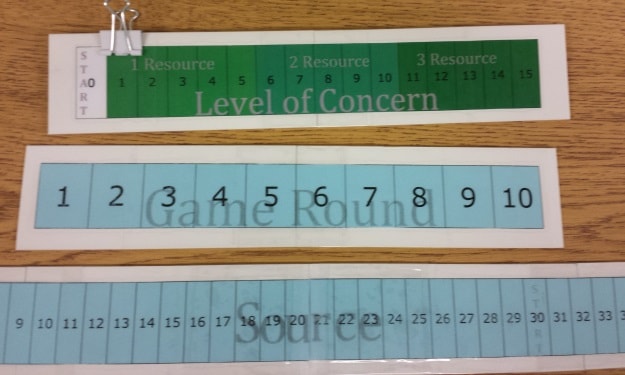 Prototype Meters for gameplay in the classroom.
Prototype Meters for gameplay in the classroom.
Happy Summer, readers of Spielbound.org!
I hope that all of the teachers in the audience are recharging their batteries for next school year. But, if we're honest, many teachers are spending at least part of their summer making enhancements to their curricula. I'm no exception.
This summer I'm spending several weeks designing, writing, and building a game for my classroom. Why do this from scratch? I have several reasons that I want to share.
The beauty of incorporating gameplay into a classroom is that there is no one "right" way to do it, so long as a teacher has an educative rationale. Maybe you'll use a game purchased at a discount through Spielbound to help students keep their math proficiency sharp. Maybe you need a historical game to really help students do some deep thinking about the expansion of railroads during the Industrial Revolution or help them think about city planning. If a pre-existing game fits your objectives, go for it! Unfortunately, there aren't always games that fit all objectives and this is where I am taking matters into my own hands. This helps me target the exact ideas that I need to make good use of my curricular time, and also gives me the freedom to write the game with the needs of my own students in mind.
I have a few objectives in my science classroom that I'm trying to help students meet and exceed. The topic is global climate change, a set of required Nebraska State Standards for my science class. Students need to understand the wide body of evidence and ethical dilemmas surrounding the study of this scientific fact. I also want to use this as an opportunity to practice rich thinking in cooperation with their peers. Students can use those interactions to develop breadth and depth in their construction of understanding. Those are big goals, to be sure, but calculated risks are what drive really rich learning. I've already put about ten days in. So where did I start?
The basic structure of the game needs to have a few elements that will help students to think within and beyond their own experience. One of my very first decisions was to make the game cooperative. This not only has the benefit of getting students to work together with ideas, but it also may prevent them from seeing global climate change as a mutual threat to all. One of the big downsides of group work is that certain personalities can tend to dominate the conversations. One of the most powerful tools in our toolbox for this, as teachers, is to define roles for students that both encourage and limit the extent to which students are part of a conversation. I want students to have a concrete focus for sharing their ideas, yet I don't want a student to drown out the voices of others. The roles I chose that are related to this particular concept are Education, Government, Industry, Public, and Research. Each role has aspects of the game that they are "in charge of", each has a discussion focus to help encourage students to find their voice, and each has a "Special Action" unique to them that logically follows what these real life "entities" have on global climate change. They will "win" or "lose" the game together and the more cooperation that happens the more likely victory can be achieved.
 Prototype Meters: Game Round, Source, Sink, and
Carbon Dioxide.
Prototype Meters: Game Round, Source, Sink, and
Carbon Dioxide.
The game focuses on several data-based Meters related to global climate change. The Carbon Dioxide Meter is the main aspect of the game that students are trying to lower. Carbon dioxide exacerbates the greenhouse effect and has been driving climate change since the Industrial Revolution. The Source Meter and Sink Meter play off of each other in the game, with Source representing human activity that increases atmospheric carbon dioxide and Sink being natural and human ways of "sucking up" that carbon dioxide so that the greenhouse effect is not as pronounced. The final two Meters track human levels of concern about the problem and the game rounds in which players get to make choices.
Speaking of those choices, the basic idea behind the game is that players can earn "action points" that they can spend on specific goals that will help influence the game Meters and slow or reverse climate change. I've decided that the group having a question-driven discussion will be the way to earn these action points. They can then spend those action points as a kind of currency to pursue goals that change the Meters.
 Prototype Meters: Level of Concern, Game Round,
and Source.
Prototype Meters: Level of Concern, Game Round,
and Source.
The pictures in this blog post show off the prototypes I've created of each of the Meters. They are simply printed on paper, taped to heavy cardboard and then faux laminated with clear packing tape. I want to be cognizant of all of the logistical barriers to quick play in the classroom, so the larger meters can be folded for easy setup and storage.
There is still a long way to go and a lot of writing to do, but the basic framework is pretty well set. Over the next few months I'll give further updates on writing, design, construction and play-testing. The goal is to pilot the game this year in my classroom! Stay tuned for more updates. As always, let the staff at Spielbound know what we might be able to do to help you incorporate gameplay in your classroom or school, from simple to complex. Teachers can reach me at teachers [at] spielbound.org.
